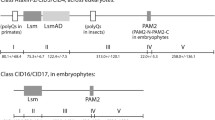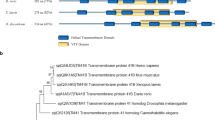Abstract
Ataxin-2, the gene product of the human spinocerebellar ataxia type 2 (SCA2) gene, is a protein of unknown function. Ataxin-2 interacts with ataxin-2-binding-protein 1 (A2BP1), a member of a novel family of putative RNA-binding proteins. Because the sequences of ataxin-2 and A2BP1 are evolutionarily conserved, we investigated functional aspects and expression pattern in the nematode Caenorhabditis elegans. Human ataxin-2 has 20.1% amino acid identity and 43.9% similarity to its C. elegans ortholog, designated ATX-2, that encodes a predicted 1026 aa protein. One of the worm orthologs of human A2BP1 is the numerator element FOX-1, with an overall 29.8% aa identity. We studied the expression pattern of atx-2 using the endogenous promotor coupled with a GFP expression vector. Atx-2 was widely expressed in the adult worm with strong expression in muscle and nervous tissue. It was also heavily expressed in the embryo. In order to elucidate the function of atx-2 and fox-1, we conducted RNA interference (RNAi) studies. The interfering dsRNA was introduced into larval L4 stage worms of the N2 strain by microinjection or soaking. DsRNA representing the full-length atx-2 gene resulted in arrested embryonic development in the offspring of all 58 microinjected worms. Nomarski imaging showed embryos in different stages of developmental arrest, indicating an essential role of atx-2 for early embryonic development. When fox-1 was targeted by RNAi, there was a marked reduction in the number of eggs per worm. The results presented here underline previous findings about the interaction of human ataxin-2 and A2BP1.
Similar content being viewed by others
References
Bandziulis J. B., Swanson M. S., and Dreyfuss G. (1989) RNA-binding proteins as developmental regulators. Genes Dev. 3, 431–437.
Brenner S. (1974) The genetics of Caenorhabditis elegans. Genetics, 77, 71–94.
Doolittle R. F., Feng, D. F., Tsang, S., Cho G., and Little, E. (1996) Determining divergence times of the major kingdoms of living organisms with a protein clock. Science 271, 470–477.
Fire A., Xu S., Montgomery M. K., Kostas S. A., Driver S. E., and Mello C. C. (1998) Potent and specific genetic interference by double-stranded RNA in Caenorhabditis elegans. Nature 391, 806–811.
Guedes S. and Priess J. R. (1997) The C. elegans MEX-1 protein is present in germline blastomeres and is a P granule component. Development 124, 731–739.
Guo S. and Kemphues K. J. (1995) Par-1, a gene required for establishing polarity in C. elegans embryos, encodes a putative Ser/Thr kinase that is asymmetrically distributed. Cell 81, 611–620.
Hermann H., Fabrizio P., Raker V. A., Foulaki K., Hornig H., Brahms H., and Luhrmann R. (1995) SnRNP Sm proteins share two evolutionarily conserved sequence motifs which are involved in protein-protein interactions. Nucleic Acids Res. 14, 2076–2088.
Hodgkin J., Zellan J. D., and Albertson D. G. (1994) Identification of a candidate primary sex determination locus, fox-1, on the X-chromosome of Caenorhabditis elegans. Development 120, 3681–3689.
Huynh D. P., Del Bigio M. R., Ho D. H., and Pulst S. M. (1999) Expression of ataxin-2 in brains from normal individuals and patients with Alzheimer’s disease and spinocerebellar ataxia 2. Ann. Neurol. 45, 32–241.
Imbert G., Saudou F., Yvert G., Devys D., Trottier Y., Garnier J. M., Weber C., et al. (1996) Cloning of the gene for spinocerebellar ataxia 2 reveals a locus with high sensitivity to expanded CAG/glutamine repeats. Nature Genet. 14, 285–291.
Kawasaki I., Shim Y. H., Kirchner J., Kaminker J., Wood W. B., and Strome S. (1998) PGL-1, a predicted RNA-binding component of germ granules, is essential for fertility in C. elegans. Cell 94, 635–645.
Kelly W. G., Xu S., Montgomery M. K., and Fire A. (1997) Distinct requirements for somatic and germline expression of a generally expressed Caenorhabditis elegans gene. Genetics 146, 227–238.
Mello C. C., Kramer J. M., Stinchcomb D., and Ambros V. (1991) Efficient gene transfer in C. elegans: extrachromosomal maintenance and integration of transforming sequences. EMBO J. 10, 3959–3970.
Miller J. H. (1972) Experiments in Molecular Genetics. Cold Spring Harbor Laboratory, Cold Spring Harbor, NY.
Nechiporuk T., Huynh D. P., Figueroa K., Sahba S., Nechiporuk A., and Pulst S. M. (1998) The mouse SCA2 gene: cDNA sequence, alternative splicing and protein expression. Hum. Mol. Genet. 7, 1301–1309.
Neuwald A. E. and Koonin E. V. (1998) Ataxin-2, global regulators of bacterial gene expression, and splicesomal snRNP proteins share a conserved domain. J. Mol. Med. 76, 3–5.
Nicoll M., Akerib C. C., and Meyer B. J. (1997) X-chromosome-counting mechanisms that determine nematode sex. Nature 388, 200–204.
Pulst S.-M., Nechiporuk A., Nechiporuk T., Gispert S., Chen X.-C., Lopes-Cendes I., et al. (1996) Moderate expansion of a normally biallelic trinucleotide repeat in spinocerebellar ataxia type 2. Nature Genet. 14, 269–276.
Sanpei K., Takano H., Igarashi S., Sato T., Oyake M., Sasaki H., et al. (1996) Identification of the spinocerebellar ataxia type 2 gene using a direct identification of repeat expansion and cloning technique, DIRECT. Nature Genet. 14, 277–284.
Shibata H., Huynh D. P., and Pulst S.-M. (2000) A novel protein with RNA binding motifs interacts with ataxin-2. Hum. Mol. Genet. 9, 1303–1313.
Skipper M., Milne C. A., and Hodgkin J. (1999) Genetic and molecular analysis of fox-1, a numerator element involved in Caenorhabditis elegans primary sex determination. Genetics 151, 617–631.
Author information
Authors and Affiliations
Rights and permissions
About this article
Cite this article
Kiehl, TR., Shibata, H. & Pulst, SM. The ortholog of human ataxin-2 is essential for early embryonic patterning in C. elegans . J Mol Neurosci 15, 231–241 (2000). https://doi.org/10.1385/JMN:15:3:231
Received:
Accepted:
Issue Date:
DOI: https://doi.org/10.1385/JMN:15:3:231




